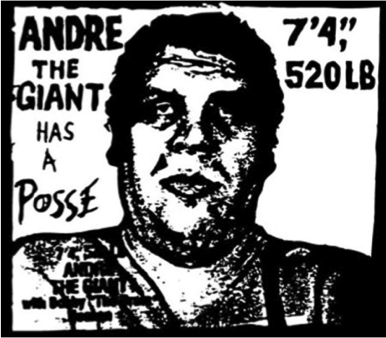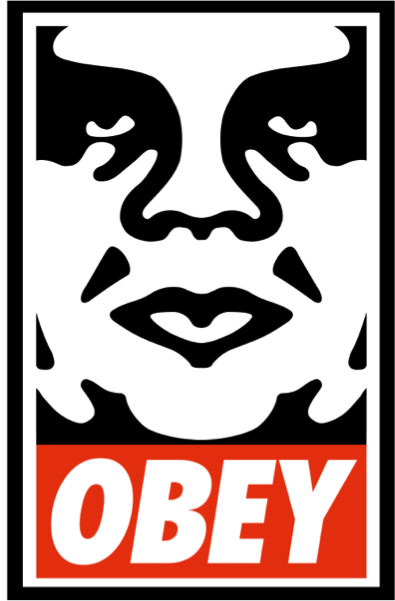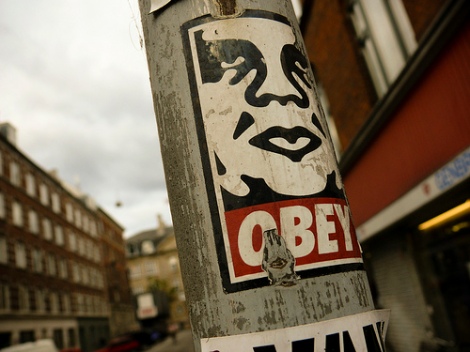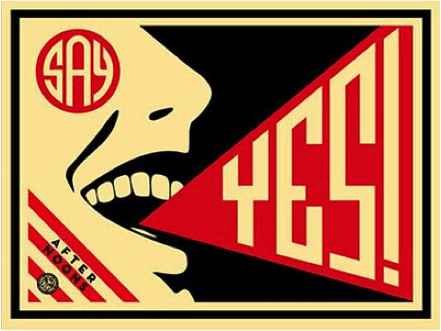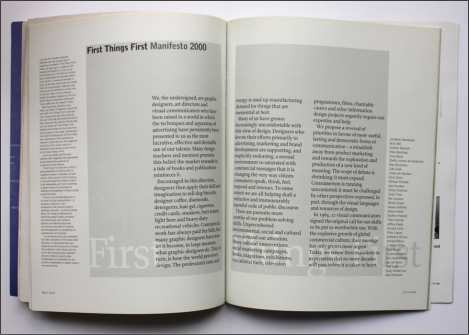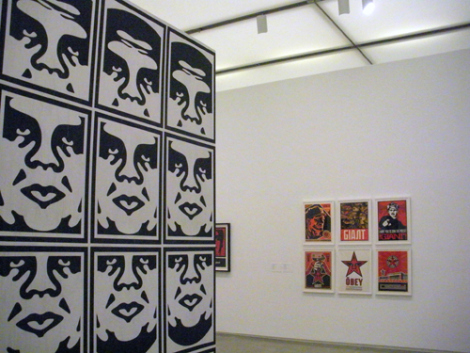In 1989, Shepard Fairey, an undergraduate at RISD, was working in a skate shop in Providence. While there, he designed a sticker incorporating an illustration of wrestler Andre the Giant, first with the slogan “ANDRE THE GIANT HAS A POSSE 7′ 4″, 520 lb” and later transforming to a design featuring just his face and the bold tagline “OBEY.” The stickers experienced initial popularity among the skater subculture in Providence, but they were quickly posted all over urban centers of the East Coast and exposed to the general public. These and other details of the origins of the OBEY campaign are documented in this short film.
Fairey describes the OBEY campaign as an experiment in phenomenology, which is essentially the study of experience and consciousness. He states in his Manifesto that the purpose of the sticker does not lie in the content of its design but rather in the cognitive and affective interaction that he intends the viewer to have with it.
“The OBEY sticker attempts to stimulate curiosity and bring people to question both the sticker and their relationship with their surroundings. Because people are not used to seeing advertisements or propaganda for which the product or motive is not obvious, frequent and novel encounters with the sticker provoke thought and possible frustration, nevertheless revitalizing the viewer’s perception and attention to detail. The sticker has no meaning but exists only to cause people to react, to contemplate and search for meaning in the sticker. Because OBEY has no actual meaning, the various reactions and interpretations of those who view it reflect their personality and the nature of their sensibilities” (Fairey).
It is meant to inspire curiosity, inquisition, and introspection in the viewer, stimulating an active response rather than the type of passive ingestion that has been engendered by the glut of commercial advertisements. Since urban public spaces are usually dominated by these advertisements, he hopes that installing visual media that diverges from them will cause viewers to take note.
Despite his denial that the sticker has any intended explicit meaning, the rhetoric “OBEY” is quite provocative. Additionally, the design itself is aesthetically similar to the Russian constructivist style associated with communist propaganda, and is distributed as such as well by being plastered up at great scale around public spaces. Given America’s history in regards to communism, it is not surprising that, by Fairey’s own admission, some viewers of the OBEY sticker, whom he classifies as the “paranoid or conservative viewer,” “may be confused by the sticker’s persistent presence and condemn it as an underground cult with subversive intentions” (Fairey). In that sense, the sticker has the power to elicit psychological and emotional injury in the viewer, whether or not it’s justified. Fairey argues that the nature and content of the viewer’s actual response, though, is not the point. “Whether the reaction be positive or negative, the sticker’s existence is worthy as long as it causes people to consider the details and meanings of their surroundings” (Fairey).
The stickers, then, seem to serve a dual role: a work of art and a medium for psychosocial conditioning. Within those categories, there is some question as to the campaign’s more precise definition, and defining the campaign is essential to evaluating its morality and value. In terms of its artistic role: since it’s distributed by being plastered on public spaces around the city, does it qualify as “graffiti?” If so, is graffiti an act of vandalism or of beauty and substance? What predicates the moral and aesthetic value of art, regardless of form? And in terms of its psychological role: can the campaign be categorized as a true “experiment” in phenomenology? If so, should it be held to the same ethical standards of conventional psychological research?
The latter question is more easily dealt with. By definition, an “experiment” manipulates a factor to determine its effect (Myers, 34-35). The OBEY campaign is obviously stripped of the formalities of experimentation; there is no controlled manipulation of a variable, nor is there a hypothesis, formal structure, or even data collection involved. Fairey perhaps sets the stage for research, but the effect of the stickers is never actually analyzed. He simply intends to inspire an effect, but he is not concerned with the actual quantification or formal study of it. It follows, then, that Fairey is not held to the codes of conduct within scientific research. His campaign, though infused with a social mission, is not a social experiment.
Despite this exemption, he still does take measures to uphold certain standards of psychological research. Although it would not be feasible for him to “debrief” with every “participant,” he publishes information about the campaign and its purpose on the internet. Anyone who sees and is discomforted in any way by the sticker can conduct a simple Google search to learn about the campaign and determine that there is no real threat. Further, this public access to the information also serves to minimize harm to the “participants.” It is reasonable to assume that anyone who responded to the stickers with anxiety or suspicion of subversive activity would be perhaps the most likely of anyone to attempt to research it, and they would be assured immediately upon this search that there is no reason to fear. Additionally, although he doesn’t acquire “informed consent” from his “participants,” that fact is part of the point of the mission and execution of the campaign. The “participants” are assaulted with advertisements every day without informed consent- they have become an assumed element of their surroundings. By adding the stickers to the mix, he is mimicking the distribution pattern of advertisements while actually attempting to provide a societal benefit by stimulating the participant’s cognitive and emotional engagement with their environment rather than perpetuating their desensitization to it. Despite the fact that the campaign cannot technically or formally be considered an “experiment,” the fact that Fairey still seems to hold himself to the moral standards of research to this extent corroborates the idea that his mission is an ethical one.
Because this social mission seems so integral to the campaign, it then becomes relevant and even necessary to integrate this psychosocial element into the evaluation of the ethics of the campaign as an artistic work, since it can’t formally be evaluated as a social experiment. In fact, there is a community of designers who unify themselves around this very mission- that design must be used to enrich society and the consumers of visual communication. The “First Things First 2000” Manifesto defines the standards for the moral community of graphic designers. A renewal of the original manifesto launched by Adbusters in 1964, the 2000 Manifesto condemns the idealization of commercial applications of design and instead advocates for social activism in design. The Manifesto contends that when designers dedicate their talent to commercial enterprises, they are helping to manufacture demand for non-essential products that both perpetuates the endemic of overconsumption and creates an environment so saturated with commercial communication that the value and power of visual media is lost.
In effect, the Manifesto introduces an ethical standard to graphic designers: to use their creativity for meaningful purposes towards the enrichment of social welfare.
“There are pursuits more worthy of our problem-solving skills. Unprecedented environmental, social and cultural crises demand our attention. Many cultural interventions, social marketing campaigns, books, magazines, exhibitions, educational tools, television programs, films, charitable causes and other information design projects urgently require our expertise and help. We propose a reversal of priorities in favor of more useful, lasting and democratic forms of communication – a mindshift away from product marketing and toward the exploration and production of a new kind of meaning” (First Things First Manifesto 2000).
The Manifesto premises two ethical frameworks: virtue ethics and deontology. By definition, virtue ethics “focuses more on the integrity of the moral actor than on the moral act itself” and “considers primarily the actor’s character, motivations, and intentions” (Trevino, 93). An evaluation of the actor’s character is based on the context defined by his “moral community,” which has its own set of norms and standards of conduct that may diverge from those of a different moral community. Deontology, on the other hand, focuses on the duties of the moral actor and insists that he make decisions based on “what’s right on broad, abstract universal principles or values” (Trevino, 91) in order to be considered ethical.
In one sense, the Manifesto allows for an evaluation of virtue ethics by establishing a moral community for graphic designers. This moral community is founded on deontological ethics because it is predicated on the idea that graphic designers have a “duty” to design for the social good rather than commercial excess. In other words, the designers with the most integrity and the best sense of ethics will internalize this duty to society and will act in ways to fulfill it.
33 designers signed the 2000 Manifesto, and although Shepard Fairey was not among them, it certainly seems that his own Manifesto reflects the same values. The OBEY campaign is explicitly anti-commercial and anti-consumerist, as it, too, rebukes the domination of our visual perceptive fields by commercial advertisements. Fairey strives to capture the attention of viewers, not necessarily in order to glorify himself as an artist, but rather in order for them to use their notice and interaction with the sticker as a gateway to think critically about all the visual stimuli around them. If this is achieved, viewers will have a renewed sense of awareness and engagement with their entire environment and will no longer passively accept the advertisements that had dulled their cognition. Therefore, from the deontological and virtue ethics perspectives set forth by this community of graphic designers, Fairey’s phenomenological agenda establishes him as a strong moral actor striving to fulfill his ethical duties to the promotion of social welfare and the integrity of design.
While it is reasonable to assume that Fairey’s campaign would be considered ethical, even virtuous, in the graphic design community, it is less clear if this is still the case in society at large. How is the sticker evaluated from an artistic perspective? Does its evaluation qualify its classification as either street art or graffiti? If it qualifies as the latter, does that inherently imply vandalism?
The most logical place to start in addressing these questions would be to first determine what defines the value of art, regardless of form. The most fundamental question in the study of the relationship between art and ethics is to what extent the ethical value of art conditions its aesthetic value, where a piece’s ethical value is defined as the ethical quality of the cognitive and/or affective attitude that it manifests, focused on the intentions rather than actual effects of the art (Gaut, 9).
There are a few different theories that attempt to answer this intrinsic question. Cognitivism holds that art’s value lies in its cognitive stimulation of its audience. In other words, the value of art is that it makes you think about that piece and prepares you to better think about other content you encounter. The presence or absence of this cognitive stimulation becomes a criterion in the aesthetic evaluation of art (Kieran, 109). Within cognitivism is the idea of immoralism, whereby “ethical defects of works can contribute to the aesthetic worth of works, and that, conversely, ethical merits can contribute to the aesthetic demerit of works” (Gaut, 11). In contrast to cognitivism, aestheticism, also referred to as autonomism, holds that “the intrinsic ethical merits or demerits of works are never aesthetically relevant-” art exists for the purpose of aesthetic beauty alone, and should be evaluated purely on those grounds (Gaut, 13).
If the OBEY sticker is evaluated through the lens of autonomism, its artistic value is based purely on its aesthetic beauty. Not only is this highly subjective, but it also voids and ignores the social purpose that is so integral to the campaign. It seems more appropriate, then, to evaluate the sticker as a work of art through a cognitivist lens. The OBEY campaign is essentially a case study in cognitivism, as its very intention is to elicit cognition and interaction with one’s surroundings. More specifically, its use of the Russian constructivist aesthetic style suggests the employment of ethically-defective means by connoting the radical and subversive communist movement. From an immoralist perspective, it is clear that this ethically-defective style is employed for the very purpose of achieving ethical merit, as it is meant to encourage viewers to mimic the antiauthoritarian mindset of challenging authority, where the “authority” to Fairey in respect to design is the gratuitous incidence of commercial advertisements that have dulled our cognizance and deteriorated our phenomenological capabilities. By doing so, the viewer will be enriched because it will better enable him to cognitively engage with his environment. This achievement, according to cognitivism, augments the aesthetic value of the sticker as a work of art. And, as previously discussed, inducing cognition, as it is evaluated as a socially-enhancing purpose of design according to the First Things First 2000 Manifesto, means that its aesthetic style contributes to its deontological and virtue-ethical virtue.
Then comes the question of the sticker’s classification, although it quickly becomes clear that this question is trivial upon exploration of the literature around the subject. The distinction between something is “street art” or “graffiti” is considered irrelevant in contemporary study of graffiti, as the concept has grown to “include paste-ups and stickers in addition to spray paint styles that derive from earlier forms of graffiti. Both street art and hip-hop graffiti have been at the fore of the global popularisation of graffiti as a cultural form, with styles referenced from one city to another in globally extending webs of subcultural relations” (McAuliffe, 129). Since the OBEY sticker clearly matches this description, its formal classification is deemed unimportant and irrelevant.
With this distinction nullified, the only question that remains is whether the stickers are an act of vandalism. If vandalism entails the defacement of property, proving both the aesthetic and the ethical merit of the stickers would dismiss this characterization. Since the aesthetic merit of the sticker as a piece of art has been established through cognitive immoralism, it is reasonable to confirm the former condition. This is corroborated by the fact that the OBEY design, among many of Fairey’s other designs, have been featured in exhibits in museums of fine art, such as his “Supply and Demand” exhibit in Boston’s Institute of Contemporary Art (Shepard Fairey – Supply and Demand). The fact that the sticker’s style of design and its pattern of distribution are unconventional does not necessarily mean that it cannot or should not qualify as art, and this formal recognition as an esteemed contemporary art form is a testament to this notion. That said, its natural and most meaningful exhibition is the urban landscape. Its pattern of distribution there is justified by its ethical mission to attempt to rival the saturation of commercial advertisements in our surroundings, and its bold, provocative style is justified by its ethical mission to capture any pedestrian’s attention and stimulate their cognition first about the sticker and then about all of the visual stimuli around them.
With that, all the technical and ethical questions presented early in the paper surrounding the OBEY campaign and its evaluation on a variety of relevant criteria have been presented resolved. It can be concluded that the OBEY sticker is an ethical enterprise from a virtue ethics and a deontological perspective, in addition to being a distinguished work of art.
Works Cited
Fairey, Shepard. “Manifesto.” OBEY. Media Temple, 1 Jan. 1990. Web. 23 Nov. 2014. <http://www.obeygiant.com/about>.
“First Things First Manifesto 2000.” Emigre Essays. Emigre Magazine, 1999. Web. 24 Nov. 2014. <http://www.emigre.com/Editorial.php?sect=1&id=14>.
Gaut, Berys Nigel,. Art, Emotion and Ethics. Oxford; New York: Oxford University Press, 2007. Print.
Kieran, Matthew,. “Art, Morality and Ethics: On the (Im)Moral Character of Art Works and Inter-Relations to Artistic Value.” PHC3 Philosophy Compass 1.2 (2006): 129-43. Print.
McAuliffe, Cameron,Iveson, Kurt,. “Art and Crime (and Other Things Besides … ): Conceptualising Graffiti in the City.” GEC3 Geography Compass 5.3 (2011): 128-43. Print.
Myers, David G. “Research Strategies: How Psychologists Ask and Answer Questions.”Psychology: Tenth Edition in Modules;. 10th ed. New York, NY: Worth Pub., 2014. 34-35. Print.
Novak, Brett. “Shepard Fairey: Obey This Film.” YouTube. YouTube, 31 May 2014. Web. 26 Nov. 2014. <https://www.youtube.com/watch?v=rcSBr4ZKmrQ>.
“Shepard Fairey – Supply and Demand.” Exhibitions. The Institute of Contemporary Art, 6 Feb. 2009. Web. 26 Nov. 2014. <http://www.icaboston.org/exhibitions/exhibit/fairey/>.
Trevino, Linda K., and Katherine A. Nelson. “Deciding What’s Right: A Prescriptive Approach.” Managing Business Ethics: Straight Talk About How To Do It Right. 3rd ed. Hoboken, NJ: Wiley, John & Sons, Incorporated, 2004. 88-109. Print.
Photos:
http://jonathanlevinegallery.com/BlogEntries/Image/ICA_8.JPG
http://lauragreen92.files.wordpress.com/2011/10/shepard-fairey-say-yes1.jpg
http://ericpetersautos.com/wp-content/uploads/2013/06/obey-pic.jpg
http://backfromthe.files.wordpress.com/2011/12/andre-the-giant-has-a-posse.jpg
http://farm3.staticflickr.com/2860/8980143790_18fb4d97ed_b.jpg
http://farm4.static.flickr.com/3528/3468246328_4ee81c830a.jpg

